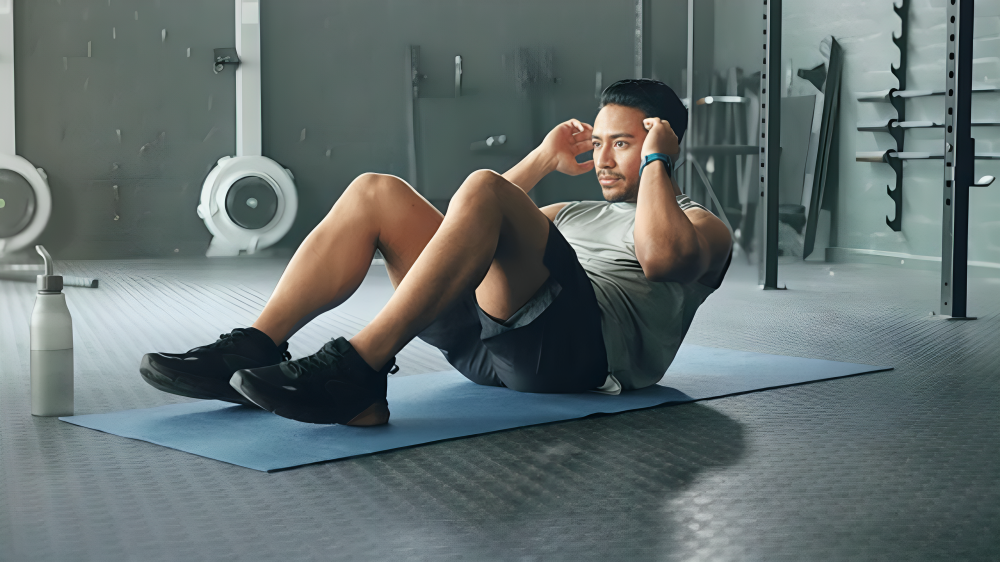
What Are Crunches?
Crunches are one of those exercises which are easy and yet effective. They are an isolation exercise that focuses on the upper part of the abdominal muscles. In a full sit-up, the whole upper body is lifted off the floor; in a crunch, the shoulders and upper back are only slightly lifted. Reducing the range of movement keeps tension on the upper abs, hence making crunches a superior exercise for strengthening this part of your core.
How to Do Crunches Properly
Find Your Starting Position:
Lie on your back on a comfortable surface, like a yoga mat.
Bend your knees and position your feet flat on the ground, hip-width apart.
Put your hands behind your head with your elbows wide, and do not interlock your fingers. You can also fold your arms over your chest.
Engage Your Core:
To engage your core, tighten the abdominal muscles as if you were preparing for a stomach punch. The engagement protects the spine and locks the focus onto your abs.
Lift Your Upper Body:
Slowly raise your shoulders and upper back off the ground, releasing your breath as you go. Think about bringing your ribcage toward your pelvis.
Press your lower back against the floor to avoid putting strain on your spine.
Hold and Squeeze:
At the top of the movement, hold for a second and squeeze the abdominals hard. This pause increases the intensity of the workout.
Lowering Back:
Inhale while you lower your upper body back down to the start position, using engaged core muscles that help you control the movement.
Repeat:
Perform about 10-15 repetitions in each set.
Benefits of Crunches
Strengthens the Core:
Crunches work on the rectus abdominis, also more commonly known as the “six-pack” muscle. Strengthening this muscle gives one a generally stronger core to improve on in building fitness and stability overall.
Improves Posture:
Core stability contributes to good posture by providing support for the spine and relieving some of the burdens or stresses in the back musculature. Needless to say, good posture works wonders for a better appearance apart from averting back pain and any other related problems in posture.
Improves Athletic Performance:
In most athletic activities, such as running and cycling, the core plays a major role in lifting weights and playing sports. Crunches build the foundational strength one requires to be at an advanced level in such fields.
Supports Daily Activities:
Everyday activities, including bending and twisting, lifting, among other related tasks, are heavily dependent on the strength of the core. Crunches ease such activities, thus involving little stress to your body.
Accessible and Convenient:
Crunches can be done anywhere, anytime, without special equipment. This makes them convenient for those who would rather work out at home or when traveling.
Encourages Mind-Muscle Connection:
It encourages a high degree of mind-muscle connection if crunches are done properly to get a feel of the abs involved in other exercises and activities.
It’s here Barbell Curl Bicep Exercise how to do it and what are the benefits
FAQs
Q1: How many crunches does one do in order for results to be visible?
A: The number of crunches a person would want to do depends on your body level and your goals. You can easily begin with 2-3 sets of 10-15 reps and build up by adding more as you get stronger. Quality is more important than quantity.
Q2: Will crunches help me in losing belly fat?
A: While crunches strengthen and firm up your abs, it does not burn one’s stomach fat directly. To burn fat, therefore, there is a need to incorporate aerobics, resistance training, and healthy nutrition in order to create a calorie deficit.
Q3: Are crunches bad for your back?
A: Crunches can be stressful to your back if performed incorrectly. To prevent injury, keep the floor pressed into your lower back and avoid neck pulling. If you have a preexisting back condition, consult a fitness expert or health care provider before adding crunches into your regimen.
Q4: Should I do crunches every day?
A: Your abdominals are like any other muscle group, in that they require rest. You need at least 24 to 48 hours of rest in between ab workouts to avoid overtraining and to assure maximum results.
Q5: Will crunches be all right to do for a beginner?
A5: Yes, crunches are quite all right if they are properly done by the beginning person. Start with a limited number of repetitions to build strength and confidence first, then add more as you get comfortable with the exercise.

